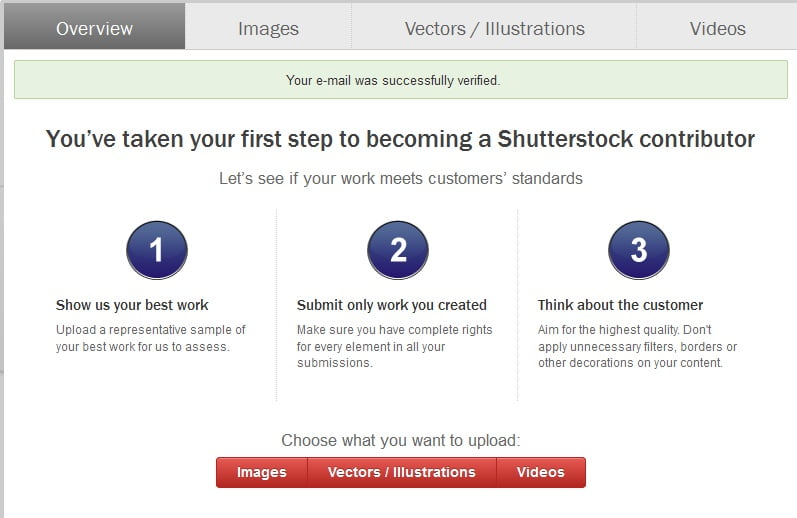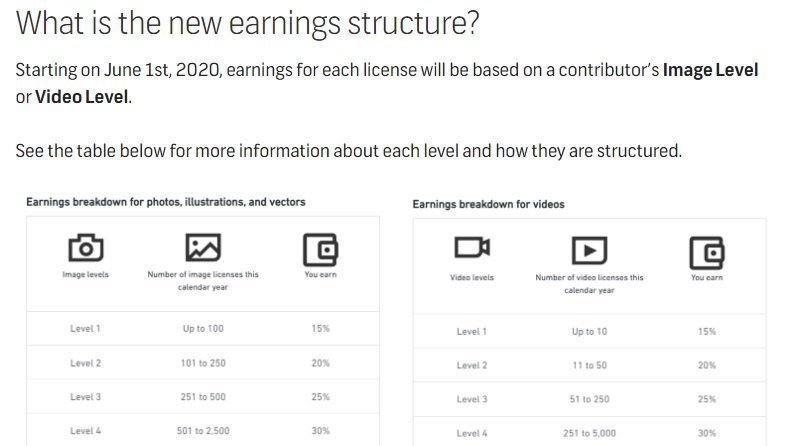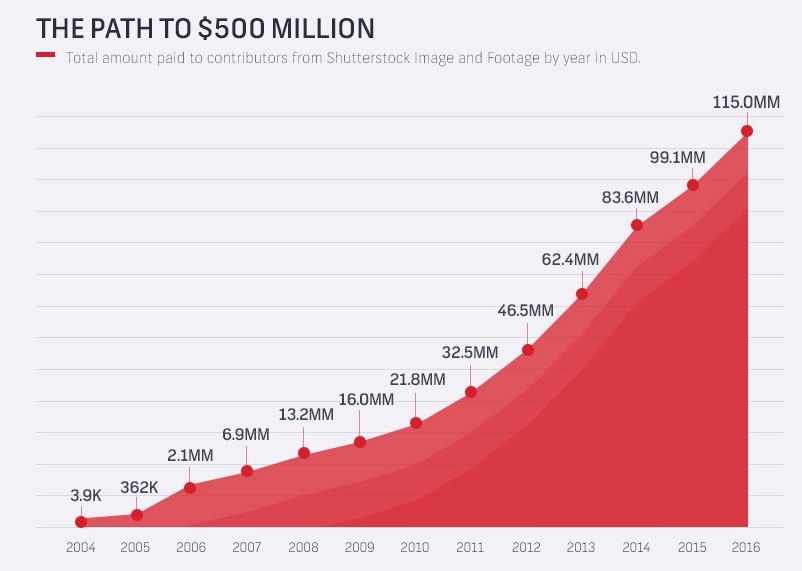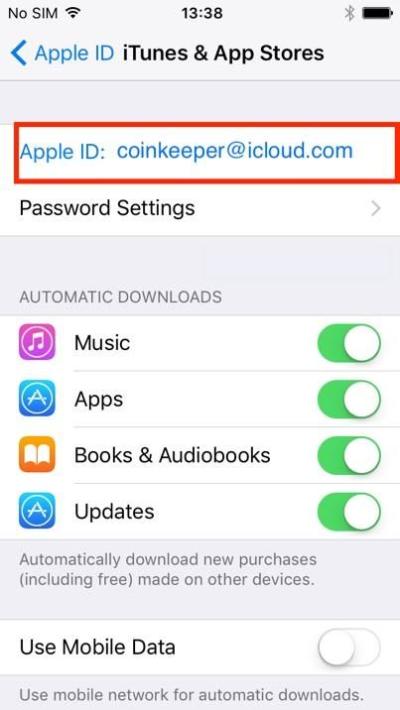If you’re passionate about photography or digital art and wondering how to turn that passion into income, Shutterstock might just be the platform for you. As one of the largest stock image marketplaces in the world, Shutterstock offers a global audience for your creative work. Their Contributor Program is designed to make it easy for photographers, videographers, and illustrators to upload their content and earn money whenever someone downloads their images. Whether you’re just starting out or already experienced, understanding how this program works is key to making the most of your contributions and turning your creativity into a steady income stream.
How Shutterstock Pays Contributors for Uploaded Images

Now, let’s get into the nitty-gritty of how Shutterstock pays you for your uploaded images. It’s actually quite straightforward, but there are a few details worth knowing. When you upload your images to Shutterstock, they enter into a marketplace where buyers from around the world can purchase licenses to use your work. Each time someone downloads your image, you earn a royalty fee. These fees are calculated based on several factors, including your contributor level, the type of license purchased, and your overall sales performance.
Here’s a quick overview of how the payment process works:
- Royalty Rates: Shutterstock offers a tiered royalty system. New contributors start at a base rate, which can increase as you make more sales.
- Earnings Per Download: The amount you earn depends on the license type:
- Standard License: Usually lower per download, suitable for most uses.
- Enhanced License: Higher payout, used for broader or more extensive uses.
- Revenue Share: Shutterstock takes a percentage of the sale as a commission, and the rest goes to you as the contributor.
Once you reach the minimum payout threshold—which is typically $35—you can request a payout through your preferred method, such as PayPal or bank transfer. Payments are usually processed within a few days after your payout request. Keep in mind, your earnings will be reflected in your dashboard, and you can track your sales and revenue at any time to see which images are performing best.
To maximize your earnings, focus on uploading high-quality, niche-specific images that meet current market demand. The better your images perform, the higher your royalty rates can climb as you advance through the contributor levels. Consistency, quality, and strategic tagging are your best bets for turning your Shutterstock contributions into a reliable income source.
Factors Affecting Contributor Earnings on Shutterstock

When it comes to earning money as a Shutterstock contributor, it’s not just about uploading beautiful images and hoping for the best. There are several factors that can influence how much you’ll actually take home each month. Understanding these can help you optimize your portfolio and maximize your earnings.
First up is image quality and uniqueness. Shutterstock values high-quality, original images that meet their standards. If your photos are well-lit, sharply focused, and interesting, they’re more likely to be downloaded. Conversely, generic or overused images tend to get less attention.
Next, consider keywording and metadata. Properly tagging your images with relevant, detailed keywords helps buyers find your work. Think about what someone searching for your image might type into the search bar. The better your keywords, the higher the chances of your images being discovered and purchased.
Image categories also play a role. Some categories are in higher demand than others. For example, business, technology, health, and lifestyle images often attract more buyers. Keeping an eye on trending topics and popular categories can help you tailor your uploads accordingly.
Another important factor is portfolio size and consistency. The more high-quality images you upload regularly, the more opportunities you have for downloads. Consistency also signals to Shutterstock that you’re an active contributor, which can improve your visibility in search results.
Lastly, licensing options and exclusivity can impact earnings. Shutterstock offers options for exclusive contributors, meaning your images are only sold through their platform. Exclusive contributors often earn higher royalties and have more promotional opportunities. If you choose to go exclusive, your earning potential can increase, but it also limits you from selling those images elsewhere.
In summary, focusing on quality, accurate metadata, trending categories, and consistency will give your earnings the best chance to grow. Keep refining your skills, stay updated with market trends, and engage actively with the platform to maximize your income potential.
Revenue Sharing Model and Payment Structure

Understanding how Shutterstock pays its contributors is key to managing your expectations and planning your photography journey. Let’s break down the revenue sharing model and how payments work so you know exactly what to expect.
Shutterstock operates on a royalty-based system, meaning you earn a percentage of each sale. The amount you earn per download depends mainly on your contributor level and whether your images are exclusive or non-exclusive.
Contributor Levels
| Level | Description | Royalty Rate |
|---|---|---|
| New Contributor | Just joined, just starting out | 30% of the sale price |
| Contributor Level 2 | After earning a minimum amount, active uploads | 35% |
| Level 3 | Consistent uploading and sales | 40% |
| Elite Contributor | Top-tier contributors with high sales volume | 42-52% (varies based on exclusivity) |
As you can see, the more you contribute and perform well, the higher your royalty rate can become. This incentivizes ongoing activity and quality uploads.
Payment Structure
Shutterstock offers flexible payout options, including PayPal, Skrill, and bank transfers. Here’s how the payment schedule works:
- Minimum payout threshold: $35
- Payment frequency: Monthly, with payments processed around the 15th of each month for the previous month’s earnings
- Earnings calculation: Your earnings accumulate based on the number of downloads and your royalty rate
It’s also important to note that Shutterstock takes a small commission for each sale, which is included in the royalty calculation. Contributors do not have to pay platform fees out of pocket; earnings are simply a percentage of each sale.
In addition, if you’re an exclusive contributor, your royalty percentages are higher, and you might enjoy additional benefits like increased visibility and promotional features. On the other hand, non-exclusive contributors can sell their images elsewhere but typically earn slightly lower royalties per sale.
To keep track of your earnings, Shutterstock provides a detailed dashboard where you can see your sales, royalties earned, and payout history. Regularly reviewing this info helps you understand which images perform best and where to focus your efforts.
In summary, your earnings are directly linked to the quality and popularity of your images, your contributor level, and your licensing choices. Staying active, uploading consistently, and optimizing your metadata can help you climb the contributor ladder and boost your revenue over time.
How to Maximize Your Earnings as a Shutterstock Contributor
So, you’re diving into the world of Shutterstock and want to make the most out of your contributions? Great! Earning more isn’t just about uploading as many images as possible—it’s about smart strategy, quality, and understanding how the platform rewards you.
Quality Over Quantity is the golden rule here. High-quality images that are sharp, well-lit, and relevant tend to perform better. Think about what buyers are searching for—trending themes, popular concepts, and unique perspectives. Invest time in editing and curating your portfolio to include only your best shots.
Next, research trending topics and keywords. Shutterstock’s search algorithm favors images that match current demand. Use relevant keywords, descriptive titles, and detailed descriptions to help your images get discovered. Don’t just sprinkle keywords randomly—make sure they genuinely describe your image.
Another way to boost your earnings is by uploading consistently. Regular uploads keep your portfolio fresh and increase your chances of getting more downloads. Consider creating a content schedule to stay consistent and track which images perform best.
Engage with the community and stay informed about platform updates. Shutterstock often runs contests, promotions, or features contributors. Participating in these can increase exposure and sales.
Lastly, consider diversifying your content. Photos, vectors, illustrations, and videos all have different audiences and earning potentials. By expanding your portfolio across different media types, you open up more revenue streams.
Remember, building a successful contributor profile takes time, patience, and a bit of marketing savvy. Focus on creating high-quality, relevant content, stay consistent, and keep learning about what buyers are searching for. Over time, these strategies can significantly boost your earnings on Shutterstock.
Payment Methods and Payout Thresholds
Understanding how and when you get paid is just as important as creating great images. Shutterstock offers several payment methods, and each has its own specifics regarding payout thresholds and processing times.
Payment Methods include:
- PayPal: One of the most popular options. It’s quick, secure, and convenient if you already have a PayPal account.
- Bank Transfer (EFT): Direct deposit into your bank account. This is a good choice if you prefer handling your earnings directly through your bank.
- Payoneer: An alternative to PayPal, especially useful if PayPal isn’t available in your country.
- Wire Transfer: Usually used for larger payouts or specific countries, but might involve higher fees and longer processing times.
Payout Thresholds vary depending on your country and payment method. Typically, Shutterstock requires you to earn at least $35 before you can receive a payout. However, some regions or methods might have different minimums, so it’s always good to check your account settings for specific details.
Once you hit the threshold, your earnings are processed according to Shutterstock’s payout schedule. Usually, payments are made on a monthly basis. For example, earnings accumulated in March are paid out in early April.
Keep in mind that processing times can vary. PayPal payments are often instant or within a few business days, while bank transfers might take a bit longer—up to a week in some cases.
To ensure smooth payouts:
- Regularly check your earning balance and payout status in your contributor dashboard.
- Make sure your payment details are up to date.
- Stay aware of any platform notifications about changes in payout policies or processing times.
Lastly, if you’re planning to withdraw large sums, consider any potential fees associated with your chosen payment method. Sometimes, using PayPal or direct bank transfer can be more cost-effective than wire transfers.
Understanding your payment options and thresholds helps you plan your earnings better. Keep track of your progress, ensure your details are correct, and you’ll enjoy a smooth payout experience as a Shutterstock contributor!
Tips for Increasing Your Income Through Shutterstock
Ready to boost your earnings as a Shutterstock contributor? It’s definitely possible with a few smart strategies and a bit of dedication. Here are some practical tips to help you maximize your income and stand out in the marketplace:
Focus on Popular and Evergreen Topics
Think about what buyers are searching for. Trends like remote work, health and wellness, or sustainable living are often in demand. Also, evergreen topics—those that remain relevant over time—such as nature, business, or lifestyle images, tend to sell consistently. Regularly researching trending keywords and popular categories can give you a competitive edge.
Optimize Your Metadata
Keywords, titles, and descriptions are your best friends. Use relevant, specific keywords that accurately describe your images. Avoid stuffing keywords—be natural and precise. Well-optimized metadata helps your images appear in more searches, increasing your chances of sales.
Upload High-Quality, Unique Content
Quality always wins. Make sure your images are sharp, well-lit, and properly composed. Unique and creative images tend to attract more buyers, especially if they fill a niche or provide fresh perspectives. Remember, high-resolution files are essential for professional buyers who need detailed images.
Consistent Uploads and Portfolio Growth
Regularly adding new images keeps your portfolio fresh and increases your chances of being discovered. Set a manageable upload schedule—whether it’s weekly or biweekly—and stick to it. Over time, a large, diverse collection can lead to more sales across different categories.
Engage with the Shutterstock Community
Participate in forums and social media groups for Shutterstock contributors. Sharing tips, feedback, and success stories can provide valuable insights and motivation. Sometimes, collaborations or feedback can help improve your work and open new opportunities.
Leverage Analytics and Sales Data
Use Shutterstock’s contributor dashboard to analyze which images sell best and why. Focus your efforts on creating more of those types of images. Understanding your audience’s preferences allows you to tailor your content for better sales.
Offer a Variety of Content
Expand beyond photos—consider contributing vectors, illustrations, or videos if you have the skills. Diversifying your portfolio can attract different types of buyers and increase your overall income.
Remember, increasing your Shutterstock earnings is a mix of quality, consistency, and smart marketing. Keep experimenting, learning, and refining your approach, and you’ll see your income grow over time.
Conclusion and Final Thoughts on Shutterstock Contributor Earnings
Getting started as a Shutterstock contributor is an exciting journey filled with potential. While it might take some time to build a substantial income, understanding the platform, optimizing your submissions, and staying consistent can make a big difference.
Many contributors find that their earnings grow gradually as they upload more quality content and learn what sells best. Patience and persistence are key. Remember, every contributor’s experience is unique—some see quick success, while others build a steady income over years. The important thing is to keep improving your craft and adapting to market trends.
Lastly, consider your overall goals. Shutterstock can be a great way to turn your passion for photography or design into a supplementary income stream or even a full-time career. With dedication and smart strategies, you can turn your creative talents into a reliable source of earnings.
So go ahead—upload that next batch of images, optimize your metadata, and keep learning. Your Shutterstock journey is just beginning, and the possibilities are endless!


